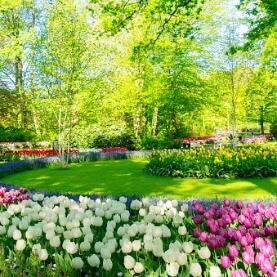
3 Tips For Creating Landscaping Zones
Jun 20th 2019
Immaculate landscapes evoke assumptions that they must have taken a high level of expertise and a colossal amount of time to produce. But in reality, the process was probably a bit easier than you imagine through the use of zoning. Landscaping zones are a great way to make a lawn appear intricate or straightforward depending on the end goal. Evergreen Lawn Care shares three tips any home or business owner can use to create landscape zones and enliven any home or business. Contact our lawn care and landscaping company in Gainesville, FL to discuss the needs of your property.
Is A Landscape Zone The Same As A Hardiness Zone?
No. A hardiness zone is based on the climate of a specific area and which plants are better able to thrive under those conditions than others. Landscaping zones are the different areas encompassing the property but have a variety of characteristics. Knowing the zones you want to implement is the first step in creating a flourishing display of flora and fauna.
1. Make A Flexible Landscape Plan
The plan lays the proverbial groundwork for what type of zones your landscape will feature and acts as a guidebook for future care and maintenance. Of course, the main part will be the style or type of landscape, but it's easy to divide everything into zones. Each may have its own identity with defined borders or blend seamlessly into one another with the help of transitions. Another key part to keep in mind is the topography — the features and shapes of the ground surface — which influences how well a specific area drains rainfall and is susceptible to erosion.
Or, a landscape designer with Evergreen Lawn Care can help design part or all the landscaping zones. We'll take your ideas and vision and translate it into a beautiful and long-lasting lawn.
English Garden
Perennials and shrubs are used predominantly in this style of landscape, which can be designed to complement the structure of a home and easily accented with decorative features such as bird baths.
Asian Garden
Evergreens, rocks, water, and a variety of plants to evoke a sense of serenity for homeowners and guests. Generally, it blends one or two focal points with several smaller corresponding elements to balance the visuals.
Xeriscape
A xeriscape garden focuses on water conservation and using natural rainfall rather than either relying on or supplementing with an irrigation system. Plants with low water requirements and those that aid in reducing water evaporation are hallmarks of this style.
Formal
Precision and symmetry are the two main characteristics of a formal landscape which, in turn, require a high amount of maintenance to keep up the manicured appearance.
Informal
Curved edges of beds gently guide the sightlines through an informal landscape. Flowers and plants have the illusion of randomness but are usually planted with a strategy to account for short- and long-term care.
Woodland
This design is good for people looking for a low-maintenance landscape that creates the feel of a wooded area in the backyard.
Butterfly
Butterfly gardens and landscapes are known for their diverse and vibrant colors, many of which attract birds and butterflies. Most are designed with the idea of providing food sources throughout the habitat while protective flowers and plants are intermixed throughout.
Organic
This style utilizes Florida-friendly plants and other native flowers and plants to eliminate the need for chemicals to fertilize and provide pest control.
2. Know The Purpose Of Each Zone
For the landscape to be truly effective, each of the planting zones should have a purpose. If there will be walkways, will they go throughout the lawn or encircle one or two zones? Sitting areas are popular for homeowners and guests to enjoy the vibrant landscape — but many people choose to limit the amount of potential foot traffic in these spots. Other zones may be strictly for viewing from afar and feature a mixture of annuals and perennials. But know that whatever the purpose, it has an impact on the maintenance required.
3. Determine Maintenance Needs For Every Zone
It's not uncommon for the maintenance needs to possibly change for each zone, but measures should be taken during planning to minimize this possibility. Watering is the biggest potential issue for upkeep. Zones with deep and/or frequent watering needs should be kept separate from others with less intensive needs. This reduces the chance of a less water-intensive area receiving too much and developing disease and pest issues as a result.
